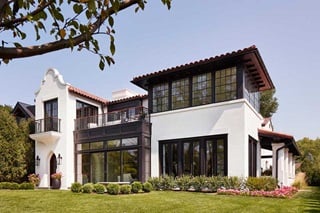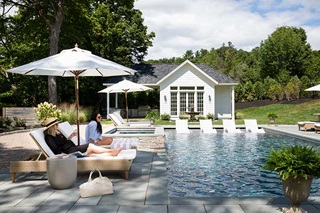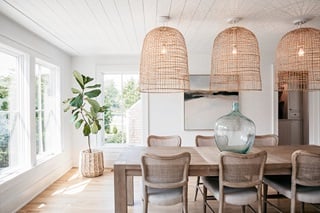Modern Mediterranean Home
While the Modern Mediterranean architectural style is more commonly found in San Diego, CA or Fort Lauderdale, FL, find out why this home is a perfect fit in this northern neighborhood.
Inspiration from Scandinavian design can be seen all around us. Learn more about its history and philosophy.
From the muted natural tones with pops of color that make up our homes and outdoor spaces, to the cozy fireplace vignettes we see across social media, Scandinavian design has become a favorite aesthetic. Terms like “Hygge” are widely embraced. So what’s the origin of this obsession with Scandinavian design? We dug in to find out where it all started and what defines it to better understand why it’s only growing in popularity today.
Where America’s Love of Scandinavian Design Started
When you think of Scandinavian design, your mind may first go to Marimekko or Ikea, and you would be close to its origin story in the US.
Post-WWII, department and specialty stores began carrying Scandinavian home products such as silverware, textiles, and glass. At the same time, several museums, including the Museum of Modern Art (MoMA), started to expand their acquisitions of Scandinavian-designed objects.
By the 1950s mid-century Scandinavian design was all the rage. Design fairs like H55 in Helsingborg, Sweden, caught international attention, and traveling exhibitions made their way to US museums.
In 1960 First Lady Jacqueline Kennedy wore dresses by Finnish textile and clothing design house Marimekko for the presidential election, opting for modern but approachable designs.
And the opening of the first IKEA store in the US in 1985 brought more affordable Scandinavian-inspired design into dorms and homes across the country.
What Defines Scandinavian Design: Three Simple Tenets
It’s easy to see why it continues to be an adored aesthetic today. Homes are a place for calm and balance. Scandinavians have adhered to this philosophy for decades, and it’s not just the Danes. Sweden has a similar concept to hygge called “mys,” which is about creating balance and calm in lived spaces.
When it comes to translating those philosophies into tangible objects, there are three main tenets that inform Scandinavian design:
1. Finding Balance
2. Blending Indoors and Out
3. Punctuating Neutrals with Brights
Let’s take a closer look at each.
Finding Balance
“Designing the space and choosing the materials is a balance of function and visuals with a focus on the things that bring warmth and joy,” said Erin Stromgren, exhibitions manager at the American Swedish Institute.
In particular, Swedish design focuses on handmade items that are built to last. These items featured quality materials like wood (teak, pine, birch), glass— especially handblown glass from the Swedish region of Glasriket—linen and other natural textiles, and ceramics. Historically, the design elements associated with Nordic trends come from the 20th Century, with a focus on mid-century furniture and aesthetics.
Underpinning all these elements is creating a sense of balance, both philosophically in the way we live and in the selections of materials, designs, and colors. Many of the ties are subliminal, Stromgren said, but each selection is thoughtful and purposeful.
Blending Indoors and Out
As alluded to earlier, part of the Scandinavian design philosophy is to focus on the surrounding natural world, incorporating woods, leathers, and other natural materials. And Norway has just the word to express their love for spending time outdoors and connecting with nature—”frilusliv.”
“Directly translated, it means ‘free-air life,’” said Joseph Grødahl, programs and operations director at Norway House. “Although a better translation might be outdoor life, outside living, or even open-air living. It means letting in as much fresh air and natural light into their indoor spaces, to keep them connected to the outdoors even while inside.”
Blurring the lines between indoors and out can also be achieved more literally by framing views of nature with thoughtfully placed windows and by opting for scenic doors to enhance natural light. Another way? Using candles or fireplaces in the winter months to bring light and warmth inside when the weather is cold and white. The beauty of the natural world enters our space to create a sense of sameness.
Punctuating Neutrals with Brights
Scandinavian design is oen associated with neutral colors, and there’s truth to that. So grays with hardwood floors are common, but these oen come from pops of color from the natural world. Those color options are endless—whether it’s the blue of the sky, green plants, or bright flowers, color is incorporated into the aesthetic.
The palette is tied back to the idea of calmness and timelessness. By using natural, neutral colors as a base, homeowners can incorporate their own creativity and design with an endless array of complimentary colors and materials.
These ideas can be seen in this Swedish Country House, which features large windows and doors with color choices like Cadet Gray on the exterior. Throughout the process, the owners were looking for ways to enhance the Swedish style.
“The homeowners shared that Sweden’s all about wonderful grays,” Interior Designer Linda Engler said. “Cadet Gray gives us just some rough punch of outline with a window that makes a statement in a very subtle, diplomatic way.”
The addition of Cadet Gray improved the look and enhanced the Scandinavian feel, and it has become one of the more popular colors for its so tones and adaptability.
With the timeless nature of the philosophy and design, it would be no surprise to see these influences into the next turn of the century.

While the Modern Mediterranean architectural style is more commonly found in San Diego, CA or Fort Lauderdale, FL, find out why this home is a perfect fit in this northern neighborhood.

The Connecticut home is all about capturing light, connecting with nature, and creating lasting family memories.

Lifestyle influencer Liz Joy turns a fixer-upper into a chic oasis for her family of five.